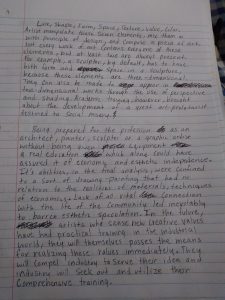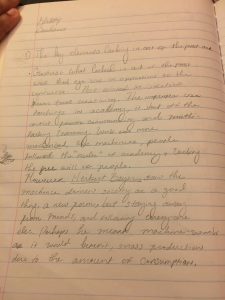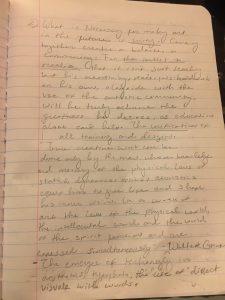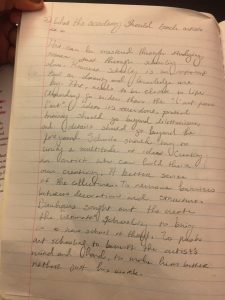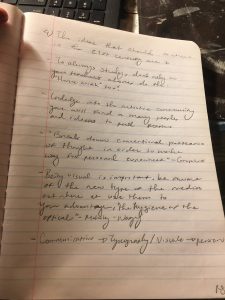Month: October 2019
Jeremy Eisner October 7th.
There are many things that artists have thought the past lacked and what the future holds. In olden times, the artists and designers did the vast majority of their work by hand. As many of these authors discuss, the invention of mechanical machinery aided them in their day which was not done before. Herbert Bayer felt that this trend of newfound machinery will consume the future of design and the vast majority of designers would be using it in mass supply. He figured that most books would become microfilm, and we would form a much simpler communication electronically that made reading less important. In a sense, he was right as today we have the digital age where we talk through electronic devices using simplistic emojis and short hand to speak to each other.
Laslo Baggy also felt the same way about technology of the future, that the majority of designers will rely on a trend of technological advancements. In this case, that advancement is typo photography which he believed would be that the future would utilize without end.
As for what an academy should teach designers, Walter Gropius felt that these schools were too conventional and never let the designer experience true design. He felt that schools were taught to be about boring paper work, and something like design requires an inner touch and expression that can only come out if inspired rather than as an assignment. To this extent, I agree that something as visual and creative as design should not be seen as boring, mundane work. Today, we still have some assignments here and there that are more straightforward I’ll say, but we do have a lot more freedom in our assignments than perhaps the designers of the past.
Javion Bailey Oct 7
The key elements lacking in the art of the past is the freedom to express art in unconventional ways. Artists of the past were too consumed with following the rules of that the ones before them set. Because of this art became to rigid fixed on an objective view on art. Also because of the language barrier, art from different countries couldn’t be expressed well to the common masses that didn’t indulge themselves in foregin art. This excluded people except for the ones in the higher echelon of critics for those certain types of art.
What is necessary for future art is the ability to express what one is trying to get across but to not fall into exclusivity. There needs to be a universal connection. Because of communication becoming more international, art cannot just be catered to one area or group. Also, another necessity, would be to take what the past had built up and mold into your own. Meaning craft your new ideas while still grounding yourself in the inventions of the older generations. This will create a balance in art. It will mix the previous notion of purity, giving it structure and promote forward thinking.
The academy should teach the students how to work on I believe that the academy should teach artists the value of making art universal. This will lead to a system that makes use of different cultures and provides a language that all can understand through the medium of art. Today we have something like this expressed through the internet and social websites.
Avion Bailey (October 7)
In the passage written by Herbert Bayer he touches on the idea of Universal Communication. He states “for a long time to come we will accept the existence of different languages now in use. this will continue to pose barriers to communication, even after improved”. I find this statement very pretentious. I don’t believe it is as simple to say we “accept the existence” of these different languages but we more or less respect the existence of these different languages. Behind these languages carries a lot of culture and emotion. To discuss it so matter-of-factly or just as a faze in human society does not shed light on how grand these different languages are.
Though, I do agree with him on the first move towards universal communication have been made by artists and designers. What could not be solved verbally has been solved visually. The problem with language when it comes to communication, it is not universal itself. Phrases, phonetics, context, etc have all been formed into this large homogeneous mass in which just knowing the words isn’t enough. You have to be present and willing to learn.
I personally believe that the sole purpose of art is to communicate the abstract. Abstract concepts and executions used to explain abstract ideas. It helps to send messages of the intangible, such as thoughts, feelings, emotions. Things we all possess and are hard to confuse. When someone displays an emotion, such as anger, their expression, demeanor, and attitude have already expressed that to you before words. Something that can’t always be translated by words, but by being shown.
Angel O. Oct 7 HW
Monica Jeune Oct 7 Hw#4
Obed Ledezma – October 7th HW
Some key elements that were lacking in the art field of the past were individuality and having the space to be creatively open as well as the process and production. They were so consumed with the orthodox that it hard for them to break free from it. They also lacked reproduction and the change of ownership. In the text, Gropius shows that typography of the past was not preserved as a Bauhaus aesthetic idea but more of a theoretical approach to the instruction that was not practiced. Moholy-Nagy also partakes that past art lacked the right amount of technology in photographic effects and purity of linear effects since there were no printing machines. Bayer argues the same claim in regards to that of traditional art and how it lacked the aesthetic approach of mass production of media due to the lack of special tools of typewriting, and machines. The insufficient provision of these materials that are major components and so critical to the process of creating art really did damage to the elements of production.
To me, the necessity for making art in the future is to still have a connection to the past in terms of elements but also creating a new idea that will be ahead of its time. It’s more of a feeling from within that artist to receive. Bayer in the text said that typography doesn’t need to be simple but encouraged that is should be different. He wanted to help artists from whatever time. In the text, I was able to read about Moholy-Nagy and his views on typography and how every printing press would have to possess a block-making plant as it lies in the photomechanical processes. In my opinion, art is something that must continue and be preserved because of its one of the things that live on forever. This idea or view within a piece of work that lives forever will help history and future generations. It is also important to still have a connection to new ideas and the advancement of the world as it changes every second. To be aware of the surroundings and changes happening every day globally in order to grow.
Academia should teach artists how to express themselves individually. I don’t think art should always be drawn from or have a certain connection to something other. The more individualistic art becomes the more individuality and fresh set of ideas submerge. It will help with the advancement of humanity as well as the brain. As well as being honest. Criticism goes a long way and is very healthy because it helps you grow as an artist to become stronger and more insightful. The world is changing rapidly and modernity is everywhere so its important to have those sets of artistic values in order to navigate within the art world.
Typography, color, and hierarchy are still used in the 21st century. Typography is one of the key ones because you can constantly play with it and reinvent, depending on the environment of a place as well as the time in which you’re living in. When it comes to color it has the ability to shape the mood of the environment and plays with our brains differently. Hierarchy is my favorite because it comes to play with the aesthetic of my designing process. Hierarchy is so important and elemental because it is what attracts the viewer and what you’re usually graded upon.
Rana Abdelnaby October 7
From the readings, I learned that art in the past lacked the unique characteristics that might differentiate it from the contemporaries through time and space. I think that traditional art lacked reproduction and change of ownership. I learned that Gropius shows that topography of past art did was not preserved as a Bauhaus aesthetic idea of the theoretical approach to instruction was not practised. Moholly-Nagy also indicates past art lacked sufficient technology in photographic effects and purity of linear effects as there were no typesetting or printing machines. Similarly, Bayer argues that traditional art lacked the aesthetic approach of mass production of print media due to the lack of machines and special tools of typewriting and copying. I believe, the lack of these critical components affected the art-making process and could have created gaps in understanding the history in the modern world. Hence, these key elements ought to continue being implemented in future art.
Art is a continuous phenomenon that is crucial and mandatory in the future. I can contend that there will be a need for architecture to design different objects and mass production of print media from the classical era as well as the preservation of history. As I read Moholy-Nagy views of typography, I noticed that in the future, every printing press would have to possess a block-making plant as it lies on the photomechanical processes. Hence, I believe that the art will help to continue preserving the history for future generations while also helping modern society to understand the changes happening globally. I believe also art in future will also help to preserve cultures of different people that will be crucial in studying history.
I believe that the academy should teach the artist about their field due to the changing world of art. The modern world is leaving away traditional art and embracing the modern one is schools. I have grown to see rise in technology that is shaping art from photography, painting, recording and designs. I think that Gropius through Bauhaus influence wanted to reunite the applied art with fine art in the desire of pushing back beside the creativity mechanism in reforming education of art. I conquer with Moholy-Nagy and Bayer that in modern art, designers and artists should operate in a market-oriented culture and adapt the Bauhaus philosophy of a new era. I have also seen a shift in market with current generations and I believe they also need well designed and connected emotional arts, hence, there is a need to understand different types of markets in academies.
In my opinion, the idea of writing and art designs are essential as fine and applied art since they dictate the nature of color, contour, shape and geometric of architecture Also, typography of constructivism has envisioned the visual experience of printing and sculpture, oil painting and design through computer-based programs. Moreover, digital technologies have also emerged where one can take photographs, design them, and apply different theme colors depending on the event or environment. Hence, I am confident that ideas of nature, color and architecture of the arts should continue in the digital age of the 21stcentury.
Dennis Ulloa October 7
Back then artist didn’t use they’re full potential of bring creative artist. Bayer which focus mostly on typography complain that no was being creative for a long because people rather have it simple and not do anything about it. Not only that he found it boring that as artist people should do something about it but not a lot of people did which cause this idea simple for a long time. Another author named by Moholy-Nagy had a similar problem that people needs to be creative because he wants to grab people’s attention on creativities. He believes that also that typography can change but also photography as well in a certain way. Now we have Gropius were he takes about how that artist is being isolated by the world. He states from the reading “Lack of all vital connection with the life of the community led inevitably to barren esthetic speculation.” I believe what he trying to say that people can still be artist but they’re missing something important is missing in some of the artist work or themselves.
The idea that art is something that is involved with creation because art needs to show what it can do in the future. The argument with Bayer that typography doesn’t need to be simple but something different. So his point is that in the future try to use something different that not only help the new artist but the future artist. Another thing that is needed for the future of art is that sure getting the knowledge of art is good getting from school. However, from what Gropius argue is to see what is out there so the artist themself can grasped the meaning of art. For Gropius it’s getting the experience and exploring what’s out there. Then we have Moholy-Nagy, which used art differently by combining typography and photography into what is called typophoto. Were he is using to methods of art into one. From the three articles it talks about creativity, Knowledge, experience, and combination were these are what the future of art needs.
From Bayer point of view of typography is that people should learn that typography doesn’t have to be simple. For example, what he stated “Typographers envisioned possibilities of deeper visual experiences from a new exploitation of the typographic material itself.” Meaning it is time to be creative by using typography not just with words but to make it into a design. As for Gropius he discussed about how the academy is teaching art to the people. However, it seems that he does not like how it is because what he say’s “It shut off the artist from the world of industry and handicraft, and thus brought about his complete isolation from the community.” Which I agree because it’s true that school can teach someone art but it doesn’t bring the feeling of art. His point of view is that to become a great artist is to go out and see what’s out there to understand. Lastly Moholy-Nagy talks about being creative bring out more of an artist mind. After all, he talk about how the idea of typophoto can be used for business or politician saying to understand art is study what company your working for or what goes around today.
The ideas that is still used in the 21st century for art is typography. The reason why I feel that typography is important is because it creates a message and gives people the attention. Yes making a design to make it look pretty helps but it doesn’t show what it represents. For example, typography is used to created logos for a lot of company such as museum, company, and more. After all, by using typography there are a lot of typefaces that can be used so that there is one typeface for other design. To me typography seems important but some may believe in something else and I agree because in the end we used all the ideas for art.

